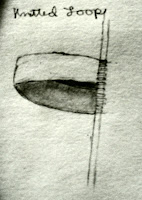Period handwriting is beautiful. A long time has passed since such a beautiful, aesthetic hand has been taught in schools. A common script in the mid-1800s was the Spencerian Ladies' Hand. It is a type of copperplate, similar to the kind that our parents (maybe??) learned in elementary school. There were numerous booklets and pamphlets written at the time to demonstrate how to write it. Many men and women also used Round Hand, which is very similar.
For those of you interested in learning how to write in a period style, Lessons in Calligraphy and Penmanship is an amazing resource to learn virtually everything you need to know to learn. They have scans of original teaching books, as well as modern guides and videos that teach you all you need to know.
 I have been trying to learn myself . I wrote out a guide in Spencerian Ladies' Hand (Left.) The darker parts of the letters are made by increased pressure, not by twisting the pen, like is common with other calligraphy "fonts". The nib you should use for this "font" should be very fine with a lot of bend to it. You can still buy Spencerian Pen Nibs. They can also be found by the boxes on Ebay. I just use what I have at hand.
I have been trying to learn myself . I wrote out a guide in Spencerian Ladies' Hand (Left.) The darker parts of the letters are made by increased pressure, not by twisting the pen, like is common with other calligraphy "fonts". The nib you should use for this "font" should be very fine with a lot of bend to it. You can still buy Spencerian Pen Nibs. They can also be found by the boxes on Ebay. I just use what I have at hand.
I couldn't find many guides that showed the order in which to write each stroke. I wrote out the order that I used to make the strokes. I tried to make the strokes in the most natural way of writing. Hopefully, if you are interested in writing it, it will be comfortable. (We have to thank Andy for the pretty red ink I got to use for the arrows and numbers.)
While I was trying to learn this style of writing, my friend told me about a friend that she has who writes amazing calligraphy. Her friend gave her some tips for me that you can read on my friend's blog, Curious Acorn.
For the lowercase Spencerian letters, please see this continuation post here.
For those of you interested in learning how to write in a period style, Lessons in Calligraphy and Penmanship is an amazing resource to learn virtually everything you need to know to learn. They have scans of original teaching books, as well as modern guides and videos that teach you all you need to know.
 I have been trying to learn myself . I wrote out a guide in Spencerian Ladies' Hand (Left.) The darker parts of the letters are made by increased pressure, not by twisting the pen, like is common with other calligraphy "fonts". The nib you should use for this "font" should be very fine with a lot of bend to it. You can still buy Spencerian Pen Nibs. They can also be found by the boxes on Ebay. I just use what I have at hand.
I have been trying to learn myself . I wrote out a guide in Spencerian Ladies' Hand (Left.) The darker parts of the letters are made by increased pressure, not by twisting the pen, like is common with other calligraphy "fonts". The nib you should use for this "font" should be very fine with a lot of bend to it. You can still buy Spencerian Pen Nibs. They can also be found by the boxes on Ebay. I just use what I have at hand. I couldn't find many guides that showed the order in which to write each stroke. I wrote out the order that I used to make the strokes. I tried to make the strokes in the most natural way of writing. Hopefully, if you are interested in writing it, it will be comfortable. (We have to thank Andy for the pretty red ink I got to use for the arrows and numbers.)
While I was trying to learn this style of writing, my friend told me about a friend that she has who writes amazing calligraphy. Her friend gave her some tips for me that you can read on my friend's blog, Curious Acorn.
For the lowercase Spencerian letters, please see this continuation post here.
























